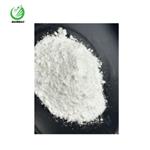Description
The lattice structure of anatase is also tetragonal, but the lower packing fraction of
the crystal lattice explains why anatase crystal exhibits both a lower hardness and refractive
indices than rutile.Nevertheless, because the crystal lattice energies of the two phases are quite
similar, anatase remains metastable over long periods of time despite being less thermodynamically stable. However, above 700°C, the irreversible and rapid monotropic conversion of
anatase to rutile occurs. From an optical point of view, anatase exhibits a greater transparency
in the near-UV than rutile.
Chemical Properties
white powder
Uses
Titania paste may be used as a transparent coating for self cleaning glass.Low optical scattering titania-acrylate nanocomposites have been reported. Metal contacts in solar cells based on titanium dioxide and di-(isothiocyanate)-bis-(2,2′-bipyridyl-4,4′-dicarboxylate)ruthenium(II) have been studied.
Uses
Titanium(IV) oxide is used as UV-resistant cloth, skin protecting cream, face washing milk, cream milk, powder make-up. It is also used as photocatalyst, self-cleaning glass, self-cleaning ceramics, antibacterial material, air purification, sewage handling, chemical industry. It is widely utilized in cosmetics, sunscreen cream, natural white moisture protection cream, beauty and whitening cream, dawn and night cream, moistening refresher, vanishing cream, chemical fiber, plastics, printing ink coating. It is likewise utilized for improving the impressionability and opacity of the paper and used for producing titanium, ferrotitanium alloy, carbide alloy etc. in the metallurgical industry.
Definition
ChEBI: Titanium dioxide is a titanium oxide with the formula TiO2. A naturally occurring oxide sourced from ilmenite, rutile and anatase, it has a wide range of applications. It has a role as a food colouring.
General Description
Titanium (IV) oxide nanopowder is widely used in skin products, additives, and foods. Nano titania has been proved to be the most active photocatalytic semiconductor under ultraviolet radiation. Titanium isopropoxide, titanium (IV) butoxide has been used as precursor materials to synthesize nano-titania.
Safety Profile
A questionable carcinogen.




